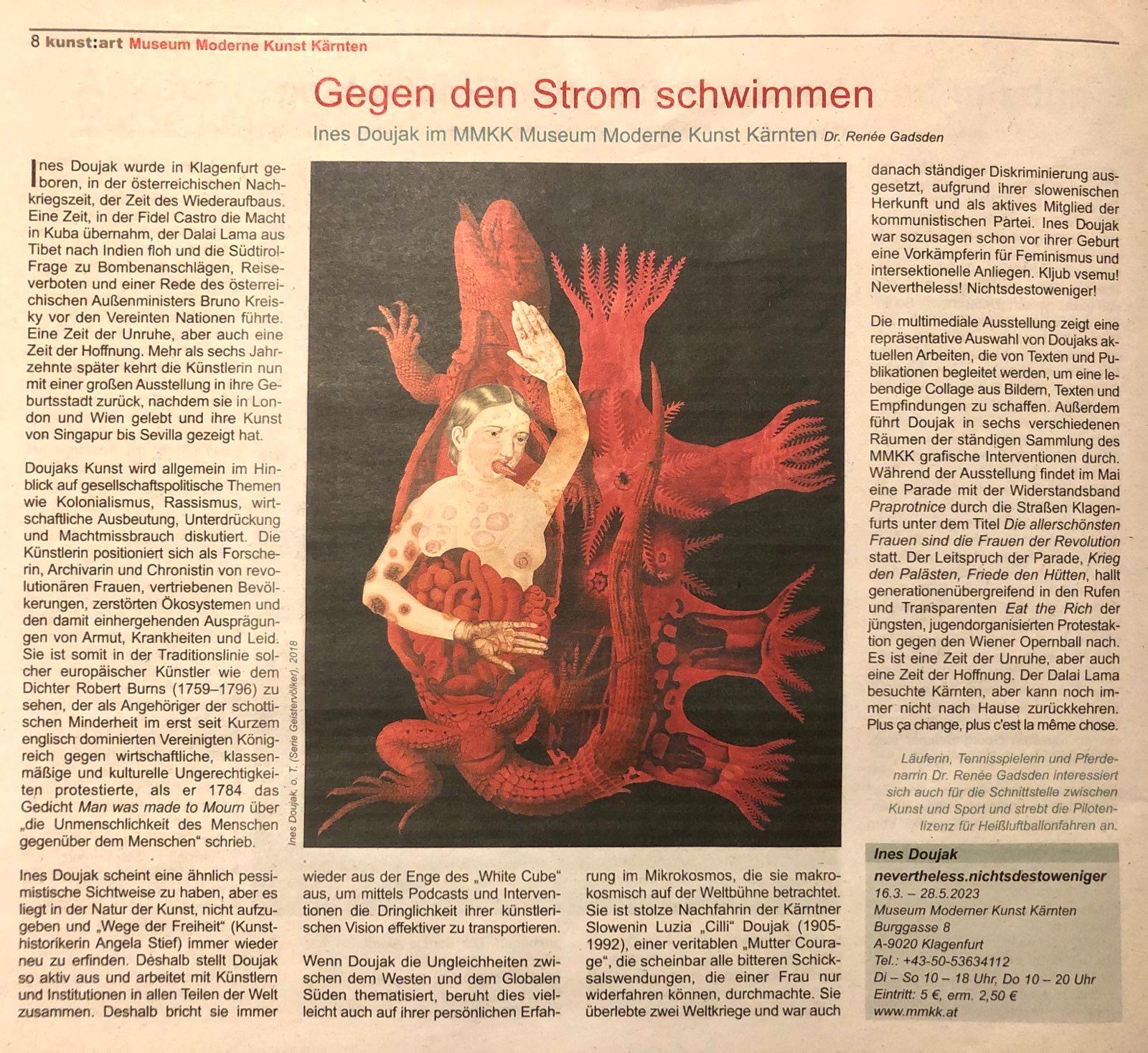aus kunst:art Nr. 90, März – April 2023 (ISSN 1866-542 X)
Swimming Against the Tide
Ines Doujak in the MMKK Museum Moderne Kunst Kärnten
Dr. Renée Gadsden
Ines Doujak was born in Klagenfurt during the time of postwar reconstruction in Austria. A time when Fidel Castro took over poweer in Cuba, the Dalai Lama fled Tibet for India, never to return, and the Südtirol-Frage resulted in bombings, travel bans, and the Austrian Foreign Minister Bruno Kreisky speaking about it at the United Nations. A time of disturbance, but also a time of hope. The artist now comes back to the city of her birth more than six decades later, after living in London and Vienna, and exhibiting her art from Singapore to Sevilla, with a major show.
Doujak’s art is universally discussed in terms of socio-political concerns of colonialism, racism, economic exploitation, oppression and abuse of power. The artist positions herself as a researcher, archivist, and chronicler of revolutionary women, displaced peoples, destroyed ecological systems and the accompanying manifestations of poverty, disease and suffering. She continues in the tradition of European artists such as the poet Robert Burns (1759-1796), who as a member of the Scot minority in the only recently English-dominated United Kingdom, protested economic, class and cultural injustices when he wrote the in the poem “Man was made to Mourn” about “man’s inhumanity to man”.
Ines Doujak seems to share a similarly pessimistic view, but it is the nature of art not to give up, and to constantly reinvent “ways of freedom”, as curator Angela Stief has spoken about. That is why Doujak is so active in exhibiting and collaborating with artists and institutions across all corners of the globe. That is why she continually breaks out of the confinement of exhibition spaces, making podcasts, parade floats and interventions beyond the “white cube”, in order to more effectively transport the urgency of her artistic vision.
When Doujak addresses the inequalities between the West and the global South, this is perhaps her personal experience, in the microcosm, examined macrocosmically on the world stage speaking. She is the proud descendant of the Carinthian Slovene Luzia “Cilli” Doujak (1905-1992), a veritable “Mother Courage” who experienced seemingly every bitter twist of fate a woman could go through, survived two world wars, and endured constant discrimination because of her ethnic roots and political views as an active member of the Communist party. Ines Doujak so to speak, was a champion of feminism and intersectional causes even before she was born. Kljub temu! Nevertheless!Nichtsdetoweniger!
This multimedia exhibition is a representative sampling of Doujak’s recent works, accompanied by texts and publications, to create a vibrant collage of images, texts and sensations. Additionally, Doujak carries out graphic interventions in six different rooms of the MMKK permanent collection. A parade action with the resistance band Praprotnice through the streets of Klagenfurt under the title “Die allerschönsten Frauen sind die Frauen der Revolution” (The Most Beautiful Women Are the Women of the Revolution)will take place during the exhibition in May. The slogan of the parade, “Krieg den Pälasten, Friede den Hütten” (War to the Palaces, Peace to the Huts), echoes across generations in the cries and banners “Eat the Rich” of the most recent, youth organized protest action of the Vienna Opera Ball. It is a time of disturbance, but also a time of hope. Plus ça change, plus c’est la même chose.
Runner, tennis player, and horse lover Dr. Renée Gadsden is interested in the intersection between art and sport, and aspires to the pilot license for hot air ballooning.
